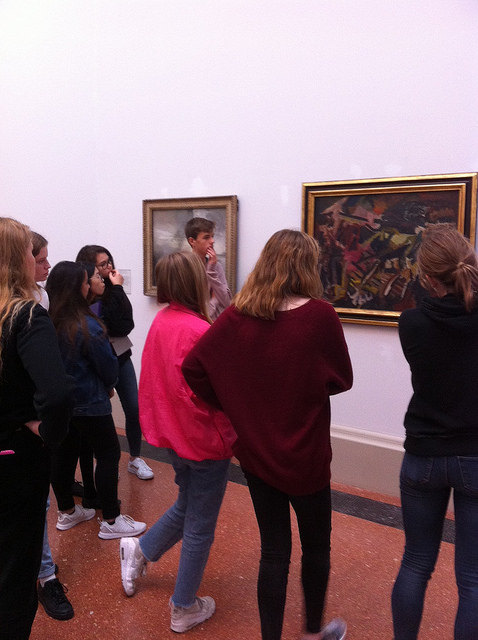HoA pupils reflect on Tate Britain visit

Having started History of Art as part of my IB only a mere three weeks ago, I am rather new to the subject. However, without a doubt, I can say that the trip to the wonderful Tate Britain has really opened my eyes to this extraordinary subject. We spent an entire day exploring galleries and enjoying lectures from University of Sussex teaching staff. The day was split into three main ‘aspects’; in the morning we looked in detail at landscapes within art, just before lunch we found ourselves immersed in the topic of war within art, then as our day came to a close we approached the topic of identity and sexuality within art.
There were many incredible pieces within the Tate’s collection, but I do believe the one that personally stood out for me today must be Derek Jarman’s Ataxia – Aids is Fun (1993). Our group came across this piece as we looked at the idea of identity and sexuality within historical and contemporary art. This piece is very similar to works by the very famous artist Jackson Pollock due to the overall impression it has and, more importantly, the rather original technique of ‘throwing’ paint onto a canvas.
A lecturer from the University of Sussex discussed with us the formal aspects of the piece. It is rather different to any other piece we looked at as when we spoke of its composition, we realized that it did not have a foreground, middle ground and background, but rather was a single layer of chaotic and somewhat angry, harsh and violent brushstrokes. This piece was key to its time as it rightfully questioned the views of sexuality. Jarman has implied to the viewer that in order to understand a piece of art, one must look beyond the initial glance; the viewer can infer that it is not in fact depicting a humorous atmosphere but rather one of pain and suffering.
Carys (I) LVI IB Art History pupil
We were lucky enough, as History of Art pupils, to go on a trip to Tate Britain and attend a number of talks by professors and a student from the University of Sussex. The trip started with an introductory talk and a look around the gallery with one of the professors. Each time we went around the gallery, we were able to explore a different period and theme of art. We started with the idea of landscapes and the changing of the depiction of landscapes over time. What I liked most about this was the way these artists were able to capture things that looked as though they were drawn from a photograph when in fact they were actually drawn from memory, such as Beyond Man’s Footsteps by Briton Rivière.
This was followed by another talk about the effect that the atomic bomb had on art. We then enjoyed another gallery trip, this time exploring art from the Second World War. Surprisingly, I found the most interesting thing was not the art shown, but the way the curators had set up the room. We discovered that the paintings had been set up in such a way to tell a story. This in my opinion was the most interesting part about the trip as I had never thought about how a gallery had been set up before and how this could influence the effect the painting has.
Tilly (K) LVI A Level pupil
Our History of Art trip consisted of three short lectures given by leading academics from the University of Sussex on their specialism. As new Art Historians, this experience really helped us to develop certain skills. Between the lectures we had gallery sessions during which we learnt about specific paintings which stood out as having a particular social or political relevance. The lectures developed our understanding of certain works of work, themes and particular artists while also helping us to improve our formal and visual analysis skills. These lecturers opened our eyes to the world of art outside the classroom.
Constantine (C) and Ollie (G) LVI A Level History of Art pupils
Flickr Gallery:


